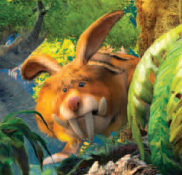| Bunny Beast | |

| |
| Name | Bunny Beast |
| Type | Mammal |
| Diet | Herbivorous (giant carrots) |
| Behavior | Docile |
Bunny Beasts are large saber-tooth Lagomorphs that lived during the Croodaceous Time Period.
Etymology[]
Their name comes from the words Bunny (Another word for rabbit or hare) and Beast (a term for a strange looking large animal).
Anatomy[]
Head-Their heads are quite square shaped and they possess short snouts tipped with a triangular but bulbous pink nose pad similar to modern rabbits. Their mouths are held open due to their tusks which poke out from the corners of their mouth and their incisors which are elongated and resemble tusks. Theses tusks may have allowed the animal a better grip on roots and stems allowing the Bunny beast to cut through tougher and larger plants than that of modern rabbits.
Eyes-Their eyes are quite beady in comparison to their body size and are all black in color however these eyes aren't typically seen due to their overgrown fur.
Ears-Their ears are quite long and point up vertically however they do slightly droop to the side and are ovular in shape with a pointed tip.
Body- They possess little to no neck which is quite thick due to their overall size. Their body is rectangular in shape and is quite robust in size. Their forelimbs are shorter than their hind limbs and they will carry them up close to their chest while running. Their legs are quite long and they possesses enormous leg bones giving them a body type similar to that of the modern Red Kangaroo or Wallaby.
Tail-They possess a tail similar to that of a modern rabbit but to a larger scale however it is more ovular in shape as well as hanging off the rear much longer comparatively.
Pelt-Their body is covered in short fur almost all the way through aside from the fur on its head which can grow so long that it covers their eyes.
Coloration-For most of their body they are covered in a tanish brown coloration with the fur that covers their eyes being a darker brown. Their bellies, chin, snout, tail, forepaws and hind feet are white in coloration with the faces markings being broken up by brown bands on the lips and around the snout. Down their back and along their rear are stripes that are black in coloration on the outer edges with white running through the middle similar to that of a Tasmanian Tiger (Thylacine).
Habitat[]
The Bunny Beast are found within thick forests and living along the plains.
Behavior[]
The Bunny Beast is not afraid of other animals as much as modern rabbits are and may actively approach large animals without hesitation. They may live a solitary life style for the most part however they are not opposed to living in groups and being very social. They are very curious and may jump into any form of shelter once it presents itself to the animal. They are quite docile and will not go out of their way to attack any animals however their large size may accidentally lead them to harming others.
Predators[]
It is unknown currently if they have any predators as they have not been observed being preyed upon unlike some of the other rodents at the time of the Croodaceous Time Period.
Abilities[]
Agility-Due to their long thick legs the Bunny Beast is able to leap to extreme heights as well as across long distances aiding in their escape from most dangers as well as any predators they may have.
Speed-The Bunny Beast is able to move extremely fast due to their long thick legs and can cover a large amount of ground.
Weight-Due to its large size the Bunny Beast is able to crush animals smaller than itself which may act as a form of self defense.
Temperature Regulation-Due to their large ears it would allow them to regulate their temperature similar to modern rabbits.
In the Movie[]
One is first seen after Grug created the "mobile home" made of rocks. A nearby Bunny Beast saw the home and immediately jumped into it which easily crushed Grug who was carrying it at the time.
Gallery[]
Trivia[]
- Another possible name for the Bunny Beast is the "Short-faced Sabre-toothed Rabbit" due to its large size and dagger-like incisors protruding from its mouth





